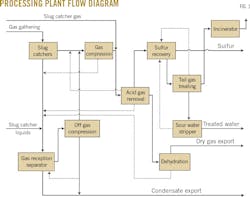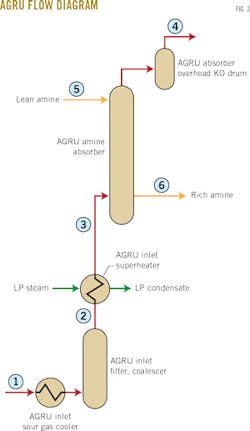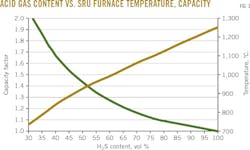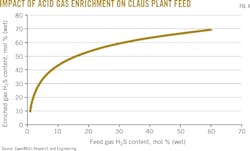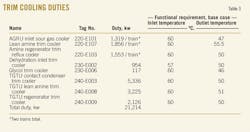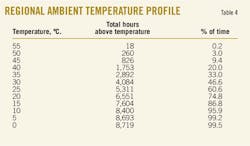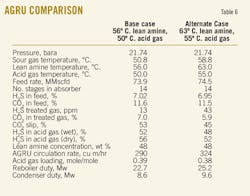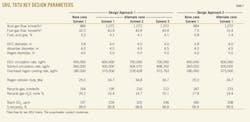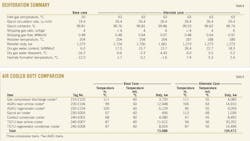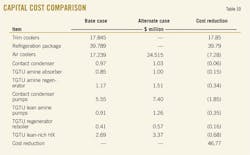Flare gas recovery systems benefit from acid gas temperature analyses
Jon Lewis
Advisian
Brentford, Middlesex, UK
A study of two methods for removing H2S and CO2 from natural gas at a Middle Eastern gas processing plant concluded that control of sour gas feed temperature can eliminate the need for trim coolers and associated refrigeration in the design of acid gas recovery units (AGRU), resulting in reduced capital expenditures, improved efficiency for other units, and increased overall plant safety.
A major operator in the Middle East hired Advisian to help select the best design and technology for a flared gas recovery project at its gas plant in the Partitioned Zone between Kuwait and Saudi Arabia.
The selection process investigated two approaches: a base case and alternate case. The base case was a traditional approach using refrigeration to allow relatively cool operation of the amine systems in the AGRU and sulfur recovery unit (SRU) tail gas treating units (TGTU), while the alternate case considered warmer operation of these systems with no refrigeration. The alternate case also assessed the impact on design of unit operations downstream of acid gas recovery with respect to product and emission specifications, including potential impacts on capital and operating costs.
The study concluded that the alternate case could save the operator about $46 million in capital expenditures: $57 million as result of trim cooler and refrigeration deletion, mitigated by $7 million from the increased costs of air coolers, and a further $3.5 million associated with larger equipment items in the TGTU.
Project approach
The selection of technology for an AGRU involves assessment of several considerations unique to the particular application. These may be grouped into broad categories that include acid gas component partial pressure, contaminant removal, and flow-quantity.
Design problems facing the operator's goal to recover flared gases at its Partitioned Zone plant included feed gas compositional uncertainty, the presence of acid gas components, and tight emission specifications.
Underlying the approach was the basic premise that gas plant design should be considered holistically, as the operation of one unit inevitably will influence operation of units upstream and downstream of the AGRU.
Partial pressure criteria consider the partial pressure of acid gas components in the treated gas relative to that in the inlet stream. In selecting technology, then, the study considered the following four factors:
• H2S removal with no CO2 present.
• CO2 removal with no H2S present.
• H2S and CO2 removal.
• Selective removal of H2S in the presence of CO2.
Excluding cases of LNG pretreatment, the key difference between H2S and CO2 removal is that H2S is normally removed to ppm levels, whereas CO2 is normally removed to vol % levels.
Various published charts are available from industry associatons1 as well as technology providers to guide technology selection, but many of these charts predate widespread use of current technologies. When considering technology for contaminant removal, however, questions generally asked involve whether the amount of heavy hydrocarbons and levels of organic sulfur are sufficient to influence technology selection.
While considerations can include climate, geography, and logistics, this study adhered to two principal considerations:
• Selectivity of H2S removal over CO2 was required so as not to place too great a challenge (e.g., excessive fuel gas support) on the design of the SRU, as the presence of BTEX in the feed gas and its subsequent removal in the AGRU required an elevated furnace temperature in the SRU.
• In the base case, hot ambient temperatures required a chilled water system to supplement the use of air cooling.
The base case
Fig. 1 shows a block diagram of the Partitioned Zone processing plant.
Plant design centered on achieving key treated gas specifications as stipulated by the operator (Table 1). In addition to these specifications, emissions from the SRU thermal oxidizer were to be limited to 225 ppm SO2 (dry basis, 1% mole excess O2).
The project team used a formulated methyldiethanolamine (MDEA)-based solvent to meet the requirements of selectivity of H2S over CO2, which also met the H2S specification in the treated gas.
Fig. 2 shows a simplified flow scheme of the absorption section. Table 2 presents corresponding stream data for the absorption section, including acid gas details.
To achieve the targeted specifications, the project team considered the ultimate design case, with maximum sour gas flow for summer conditions. The acid gas, accordingly, was routed to the SRU.
The primary consideration for the design of an SRU is achieving the required furnace temperature for stable combustion. In the absence of combustibles apart from H2S, this is 1,000° C.
In the present case, however, the occurrence of significant benzene, toluene, ethyl benzene, and xylene (BTEX) required a furnace temperature of 1,160° C. to ensure their complete destruction in the furnace.
Fig. 3 shows the influence of H2S content in the acid gas on furnace temperature and SRU capacity.
An H2S concentration approaching 90% in the acid gas is required to achieve a furnace temperature of 1,160° C., though the presence of hydrocarbons in acid gas that increases furnace temperature by about 30-40° C./% would reduce this concentration. Because H2S concentration in the present case was only around 50%, the required furnace temperature could not be achieved without additional measures.
For lean acid gas feeds, acid gas enrichment (AGE) sometimes can be employed upstream of the Claus plant. An H2S-selective solvent would be used in an absorber. This solvent, typically, would be the same as that used in the amine section of the TGTU and would have common regeneration. A potential downside of this approach is that non-H2S containing sulfur species (e.g., mercaptans) would be routed directly to the thermal oxidizer and lost as SO2.
The team, however, determined AGE to be unsuitable for acid gas in the present case, as a selective solvent was used in the AGRU to increase H2S concentration to above the level where an AGE would be appropriate.
Fig. 4 shows the impact of AGE on Claus plant feed.2
Furnace temperature
Apart from AGE, four options exist to increase furnace temperature:
• Combustion air preheat.
• Acid gas preheat.
• Oxygen enrichment.
• Fuel gas co-firing.
For the base case, both the acid gas and combustion air streams were heated to 240° C. using high-pressure steam, and subsequently to 350° C. and 400° C., respectively, using electric heating. Fuel gas support, however, was required.
Cooling
Air coolers reduced process stream temperatures to 60° C., with additional trim cooling to the required process temperature provided by a chilled water system. The selection of 60° C. was a nominal 10° C. above the maximum ambient temperature of 50° C., and was prescribed as part of front-end engineering and design (FEED) for the project.
Table 3 shows the seven chilled-water duties required for the project.
The study also specified a propane refrigeration package to supply chilled water to these trim coolers, which together with the coolers themselves, resulted in a total installed cost (TIC) of about $57.6 million.
The alternate case
The alternate design objective was to remove trim cooling and refrigeration operations. Several factors drove the decision to perform the alternate study, including:
• Ambient temperature profile.
• Air cooler approach temperature.
• Relaxed treated gas H2S specification of 50 ppm.
• Acknowledgement that the specification for treated-gas water content was arbitrary.
• Economic considerations.
• Opportunity to increase inherent overall safety of the plant.
The team also determined that operation at an increased temperature had a beneficial impact on the plant's upstream gas reception area as a result of reduced condensate recycling.
Approach temperatures
The ambient temperature for the Partitioned Zone, which is hot during the day and cold at night, is only above 40° C. for 20% of the year.
Given that ambient temperatures in the region are at their highest only during the summer months, the team was able to design for a theoretical air temperature with an acceptable exceedance.
Table 4 shows the regional ambient temperature profile, reflecting day-night variation.
The team determined the 10° C. air-cooler approach temperature as stipulated by project guidelines should not be considered prescriptive. Approach temperature may be reduced if mitigating measures are considered.
Air flow, for example, can be increased to reduce the exchanger's outlet temperature and improve the mean temperature difference (MTD). A disadvantage to this approach, however, is that power required for fans will increase and the aspect ratio of the bundle may increase.
An increase in the number of tube passes, alternatively, could improve MTD and avoid adverse temperature gradient in the bundle. Under these circumstances, the unit would behave like a countercurrent flow rather than pure cross flow exchanger, which may require a higher pressure drop on the process side.
Treated gas specification, moisture content
The project team easily achieved the treated gas specification of 50 ppm by using an increased sour gas feed temperature of 59° C. This temperature allowed deletion of the upstream trim cooling duty given that an approach temperature of 5° C. in the preceding air cooler could be achieved at the maximum ambient temperature of 50° C., which preliminary design of the air cooler indicated was possible. The selected solvent provided leeway to use the margin while still maximizing CO2 slip.
The 7 lb/MMscf treated-gas moisture content was an arbitrary value based on typical specifications. With moisture content designed to remain above the hydrate and water dew point, the team was able to use the high ambient temperature as an advantage in its design.
Study cases
The minimum air cooler approach temperature for the alternate case design was set at 5° C., with removal of all trim cooling. This gave an air cooler outlet temperature of 55° C.
Table 5 shows a temperature comparison between the alternate and base cases for the AGRU absorber referencing streams shown in Fig. 3.
Table 6 shows a detailed comparison of key parameters within the AGRU. The increased operating temperatures in the AGRU resulted in an increase of around 10% in the amine circulation rate and hence reboiler and condenser duties while still allowing treated gas specifications to be met.The project team found that the decrease in CO2 slip, however, adversely impacted SRU operation.
Design problems for the SRU and TGTU were two-fold.The reduced CO2 slip required an increase in fuel gas co-firing, which was of particular concern due to fuel gas compositional variability. Feed-forward control was used to mitigate this.
A second concern involved SO2 emissions that resulted from increased amine temperature arising from deletion of trim coolers. H2S selectivity is key to the amine section in the TGTU, and in the base case, recycle flow to the SRU was around 17% of the acid gas flow from the AGRU.
No flexibility was available regarding the project's emissions specification of 250 ppm SO2 (dry basis, 1% mole excess O2), which required application of a margin to reduce this to 225 ppm. There was no indication, however, whether this specification was to apply at any time and with any ambient temperature, or whether a daily average figure could be used.
Two approaches were employed to design the SRU and TGTU, with three solvents considered in the TGTU.
Design Approach 1 was a traditional Claus Plant configuration, while Design Approach 2 was a variation showing advantage in terms of emissions reduction, but not necessarily for overall plant design.
Table 7 provides a summary of key design parameters in the SRU and TGTU, highlighting impacts of the increased AGRU operating temperature.
Stack-SO2 emissions exceeded specification slightly with Design Approach 1. Design Approach 2, however, allowed the team to achieve specification, with all TGTU column diameters and circulation rates increased.
These results reflect the ultimate design case (maximum sour gas flow for summer conditions) as well as a more likely flow scenario under which, 97% of the time, the plant also achieved its emission specification with the ambient temperature below 50° C.
Dehydration
Deletion of both the dehydration inlet trim cooler and glycol trim cooler within the regeneration system alongside an increased operating temperature in the AGRU affected the plant's dehydration system.
Sweet gas leaving the AGRU was routed directly to the glycol contactor, which impacted the degree of achievable dehydration (Table 8).
To address the issue, the study investigated several scenarios, including varying the stripping gas rate with a fixed increased glycol circulation rate and maintaining reboiler temperature or duty. None of the considered scenarios, however, achieved the requisite 7 lb/MMscf specification.
Given the site's location in the Partitioned Zone and the fact that the gas was used internally across the entire plant, the dehydration level and water dew point achieved was deemed suitable.
Air cooler comparison
Design led the bulk of the trim coolers' duty to be transferred to their associated air coolers, though impact to the TGTU resulted in an overall increase in cooling duty (capacity) of about 10 Mw.
Table 9 shows a comparison of air cooler duties.
Capital cost comparison
As part of the study, the project team executed a TIC comparison for pertinent major equipment. While this is by no means a complete estimate, the comparison shows that the savings afforded by deletion of the trim coolers and refrigeration system far exceeded increased costs of the heightened air cooling duties and TGTU equipment.
Table 10 shows the TIC comparison for major equipment included in the project.
Operating costs
While the study did not undertake a comprehensive analysis for operating expenditures, a high-level assessment of power costs associated with the refrigeration package suggests the plant can achieve a savings of more than $2 million/year. This savings would be mitigated by increased air cooler fan power and increased power associated with AGRU and TGTU pumps.
References
1. GPSA Engineering Data Book, 13th Edition, Tulsa: Gas Processors Suppliers Association, 2012.
2. Fedich, R., Parks, L., and Perry, D. "Flexsorb SE: A proven reliable acid gas enrichment solvent," 89th GPA Annual Convention, Austin, Tex., Mar. 21, 2010.
The author
Jon Lewis ([email protected]) is global director of gas processing for Advisian, the independent consulting business line of WorleyParsons Group. His responsibilities span consultancy, project delivery, client support, and business development. He has extensive conceptual and detailed engineering experience and has held various roles associated with gas processing terminals, offshore platforms, and refineries in his 22 years with the company. Lewis holds an MS (1980) in advanced chemical engineering from the University of Manchester, UK, and is a chartered engineer.
